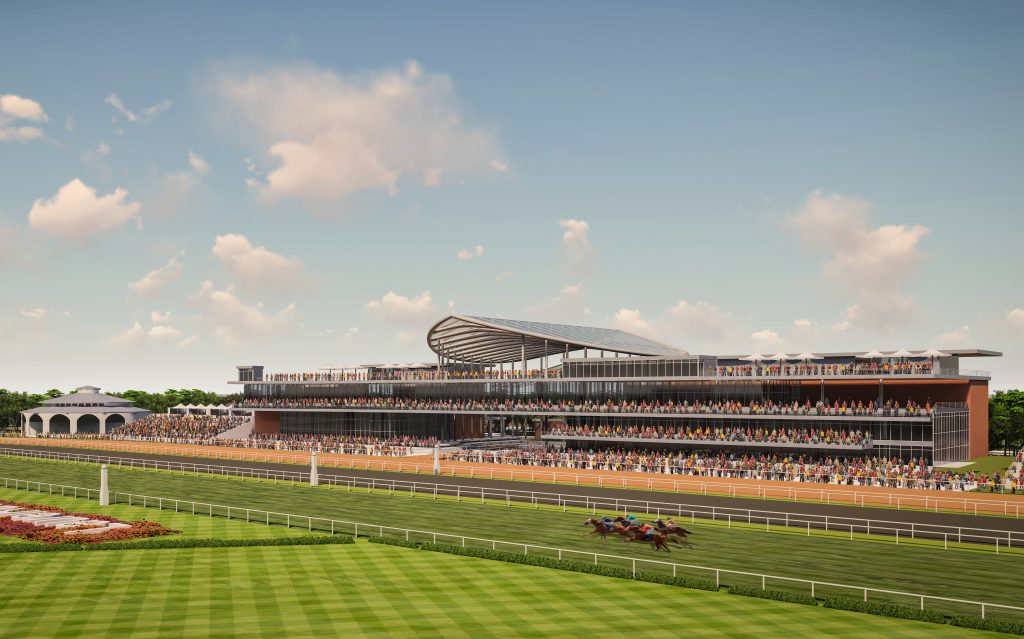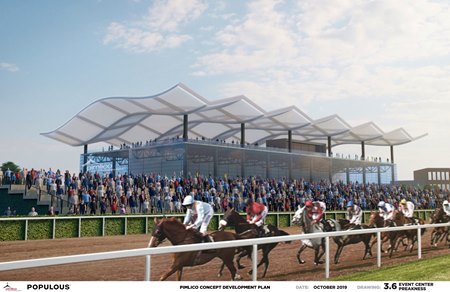
On Tuesday, February 25, the Maryland State Senate will hold hearings on Senate Bill 987 better known as “The Racing and Community Development Act of 2020” (SB987/HB1056). If passed into law, this will fund the complete renovations of Pimlico Race Course in Baltimore, Maryland, and Laurel Park Racetrack in Anne Arundel County, Maryland.
With funding in place, ownership of Pimlico will be transferred from The Stronach Group (TSG) to the City of Baltimore or possibly to the Maryland Stadium Authority upon recommendations of some legislators. Ownership of Laurel Park will transfer to Anne Arundel County whose current County Executive is Steuart Pittman, founder of the Retired Racehorse Project and owner of Dodon Farm in Anne Arundel County.
Under the agreement, TSG would retain ownership of The Preakness Stakes, the Woodlawn Vase and the Maryland Jockey Club. TSG would sign a 30-year lease deal to hold the Preakness at Pimlico, two months for set up and breakdown and pay $10 million a year for overlay for Preakness seating and accommodations such as temporary barns and hospitality.
The legislation seeks $180 million for Pimlico, opened in 1870, and $155 million for Laurel Park, opened in 1911, to raise and rebuild both facilities from the ground up. Funding will be in the form of bonds sold through the Maryland Stadium Authority, monies from the Lottery and slots through the Racetrack Facility Renewal Account (RFRA). The bonds are required to be paid within 30 years.
All of Laurel’s 193 acres will be dedicated to development related to the track. There will be a modern, state-of-the-art grandstand built with all new barns and backstretch. In addition, there will be a new MARC train station built and bridges connecting the racetrack facility to the new TSG-owned Laurel Park Station multi-use development on the other side of the station. Click here to view the Laurel Concept Plans
Only half of Pimlico’s 110 acres will be related to the racing facility with the remaining surrounding acreage leased or sold for commercial development. Proposed are multi-use housing, a hotel and parking garage for use by Sinai Hospital and a grocery store. The current clubhouse built in 1960 and grandstand built in 1922, 1954 and 1959, will be replaced with a glass civic center/clubhouse. The racing oval will be rotated 30 degrees and shortened to 15/16th of a mile with two chutes. The infield will contain multiple athletic fields, a pond and footbridge. Click here to view the Pimlico Concept Plans
The original 1870 Pimlico clubhouse, known as the Old Members Clubhouse, burned to the ground in June 1966 leaving behind only the weather vane, from 1909, that now resides in Pimlico’s museum. The only part original to Pimlico that still exists is the wrought iron gate that is located at the National Racing Museum and Hall of Fame in Saratoga, New York.
Bowie Training Facility, formerly Bowie Race Track which opened in 1914 with racing ending in 1983 and the training facility permanently closed in 2015, will also be transferred in ownership. Part of that facility’s land would be turned over to the Maryland-National Capital Park and Planning Commission for recreational activities, such as hiking and wildlife viewing, and to the city of Bowie and Bowie State University for activities such as baseball and football.
The current proposed legislation is not limited to Pimlico, Laurel and Bowie. In fact, it is quite complicated. The bill consists of 42 pages, a 3-page preamble, 40 parts, 12 repeals and two additions. The legislation also calls for the creation of an Equine Health, Safety and Welfare Advisory Committee under the Maryland Racing Commission.
In 2019, there were several pieces of legislation before the Maryland House and Senate regarding Pimlico, Laurel and Bowie. A bill (SB883/HB990) was proposed to add Bowie Training Facility to the Racetrack Facility Renewal Account (RFRA) so slots funding could be accessed for improvements for the facility. Another bill (SB878/HB1070) requested $120 million in bonds, $80 million for Laurel and $40 million for Bowie, to be administered by the Baltimore Economic Development Corporation (MEDCO) with the debt service on the bonds repaid with RFRA funding. Still another bill (SB800/HB1190 ) presented by a Baltimore faction proposed establishing a Workgroup to Study the Implementation of Phase 2 of the Maryland Stadium Authority’s Pimlico Race Course. All proposed legislation failed in committee in April 2019.
Stronach Group officials had spoken to the Bowie City Council in March about their plans to invest $40 million to make the Bowie Training Center a state-of-the-art training facility.
In March of 2019, then Baltimore Mayor Catherine Pugh sued to seize Pimlico and take control of the Preakness. The lawsuit against the owners of Pimlico Race Course was in hopes of blocking them from moving the Preakness Stakes or using state bonds to fund improvements at Laurel Park. That suit was withdrawn by acting Mayor Jack Young in June.
In October, a group representing Maryland Jockey Club (MJC) and Baltimore City announced a deal to keep the Preakness in Baltimore by funding Pimlico and Laurel Park. They have since created the organization Racing For Maryland’s Future.
In 2016, the Maryland Stadium Authority (MSA) entered into a Memorandum of Understanding with the Department of Labor, Licensing and Regulation and the Maryland Racing Commission to manage a two-phase study of the Pimlico Race Course for an estimated cost for both of $260,000.
Phase 1, costing $165,000 and released in February 2017, summarized the findings and recommendations related to the situational overview which included a comprehensive evaluation of the existing condition of the Pimlico Race Course from a physical, user and economic perspective and a needs assessment that outlined specific facility improvements that would need to be completed for Pimlico to continue to serve as the long-term home of the Preakness Stakes. In addition, a preliminary, order-of-magnitude cost estimate was developed to enable leadership to understand the level of investment required. MSA offered several options with site plans and an elevation drawing of a new Pimlico clubhouse inspired by the Victorian Old clubhouse. There was an estimated cost of between $250 and $322 million.
Phase 2 (Part 1,Part 2) of the MSA study began in February 2018 and was to examine how the renovations of Pimlico could be accomplished and how to finance the project. The final report, released in December 2018, was a completely different design from Phase 1. The track had been realigned to accommodate commercial development along the perimeter of the property. Proposed were a parking garage, hotel, grocery store and mixed-use housing. There would be a plaza behind the clubhouse to be used as a paddock for the Preakness meet and community center the rest of the year. There would be no backstretch, no cluster of barns. The inspiration for the clubhouse and facility design had changed to The Palio in Italy and the cost had escalated to $424 million. There was a timeline showing how the renovations could take place and how the Preakness could stay at Pimlico and all could be worked around the event.
A breakdown of costs was provided for all components of the project. The study estimates a cost of $252.2 million to rebuild the track’s main facility, $120.5 million for improvements to the infrastructure, $29.6 million for the infield and new racing surfaces and $21.6 million to demolish and remove the existing buildings. The only suggestion as to financing was that Baltimore City should pay the cost of infrastructure. However, after paying part of the cost for Phase 2 of the study ($424,000) and participating in that phase, the track owners stated emphatically they would not cover any of the costs for renovations.
Before the study there was a 10 Year Deal. In 2013, then MJC President, Tom Chuckas and Maryland Racing Commission (MRC) Chairman Bruce Quade brokered a deal with the State of Maryland, stakeholders, horsemen and track owners to tap into slots funds. The 10 Year Deal would give Thoroughbred and Standardbred racing a percentage of slots revenue from Maryland’s casinos with stipulations.
The Deal created the Purse Dedication Account (PDA) with 6% of slots revenue later reduced to 5% with openings of more casinos and additional slots, and the Racetrack Facility Renewal Account (RFRA) with 2.5% of slots revenue reduced to 1.75% and 1%, giving access to a minimum of $10 million a year, increasing to $20 million, for track improvements with 80% going to the Thoroughbred tracks and 20% to the Standardbred tracks.
The legislation created to enable funding sunset in 2023. With additional legislation the funding could have been extended.
However, 16 years after the last casino opened at MGM National Harbor in December 2016, that part of the slots fund was legislated to revert to the education fund.
In 2013, a plan was created for major improvements to both Laurel and Pimlico, in particular Pimlico “to enhance the Preakness experience.” At Laurel, Phase 1 would include construction of at least 150 stalls; Phase 2, an additional 150 stalls. There would also be infrastructure improvements like storm water, sewage and roads. Phase 3 proposals include a new clubhouse and a mixed-use development and hotel building.
The plan at Pimlico calls for a “major overhaul” to the facility, particularly in the “backstretch” area where the horses and grooms are located. Concept work for Phase 1 is underway and permit drawings will be done this year. Phase 1 would cost $15.5 million and include construction of a 130-unit grooms’ quarter building and six barns housing 216 stalls for horses.
Phase 2 would include construction of two, 260-unit grooms’ quarter buildings, a canteen building for the backstretch staff and 12 barns housing 432 stalls. Phase 3 would focus on improvements to the “patron” area of clubhouse and grandstand buildings and parking lot. The Maryland Jockey Club was evaluating costs for these two phases. Concept plans for them were to be ready in 2014 and required the approval from the Maryland Racing Commission. MJC was to receive $8 million per year from slots starting in 2014 to help find the projects. No further steps were taken with these plans.
__________________

The Racing and Community Development Act of 2020 SB987/HB1056
FOR the purpose of;
Requiring the State Racing Commission to consider the health, safety, and welfare of certain horses;
Requiring the Commission to establish the Equine Health, Safety, and Welfare Advisory Committee;
Providing for the composition and chair of the Advisory Committee;
Requiring the Advisory Committee to report on certain activities and make certain recommendations;
Requiring the Commission to include certain information in a certain report;
Altering the number of live racing days the Commission is required to award each year; requiring the owner of the Bowie Race Course Training Center, on or before a certain date, to convey certain parts of the property to certain entities;
Providing that certain parts of the property conveyed may only be used for certain purposes;
Requiring the City of Bowie to enter a certain agreement with Bowie State University;
Requiring the Mayor of Baltimore City to designate the chair of the Pimlico Community Development Authority;
Providing that certain planning, zoning, and development regulations that apply to the Maryland Stadium Authority do not apply to certain racing facilities;
Authorizing, subject to the approval of the Board of Public Works, the Authority to issue up to a certain amount of bonds for certain racing facilities;
Requiring the Authority to provide certain committees of the General Assembly a certain report before seeking certain approval of the Board of Public Works;
Requiring the Authority to obtain certain approval of the Board of Public Works;
Requiring the Authority, before issuing certain bonds, to ensure that certain long–term agreements are finalized;
Authorizing the Authority to enter into a certain agreement with certain project entities;
Prohibiting the Authority from having any responsibility for a racing facility after the completion of a racing facility;
Authorizing the Authority to assist with enforcement of certain warranties and claims; authorizing the Authority, if retained, to provide certain services;
Establishing the Racing and Community Development Fund as a continuing, nonlapsing fund; specifying the purpose of the Fund;
Requiring the Authority to administer the Fund;
Requiring the State Treasurer to hold the Fund;
Specifying the contents of the Fund; specifying the purpose for which the Fund may be used;
Providing for the investment of money in and expenditures from the Fund;
Requiring interest earnings of the Fund to be credited to the Fund;
Exempting the Fund from a certain provision of law requiring interest earnings on State money to accrue to the General Fund of the State;
Requiring the Comptroller to pay a certain amount from a certain fund each year that certain bonds remain outstanding and unpaid;
Altering the allocation of the Racetrack Facility Renewal Account;
Altering the distribution of proceeds from video lottery terminals;
Requiring that certain local impact grants are distributed in a certain manner for certain fiscal years;
Allowing a subtraction modification under the Maryland income tax for gain received as a result of the transfer of certain property and the amount of any income realized as the result of an expenditure by certain governmental entities;
Providing an exemption from the sales and use tax for the purchase of certain personal property used for certain purposes;
Providing an exemption from certain property taxes for certain improvements at certain locations;
Providing that transfers of certain property between certain entities are not subject to certain recordation and transfer taxes;
Prohibiting the Authority from expending funds for construction of certain surfaces until certain entities provide the Legislative Policy Committee with a certain report;
Requiring certain entities to enter into a certain memorandum of understanding that contains certain provisions;
Prohibiting the Authority from beginning construction of a certain site until it receives a certain memorandum of understanding;
Requiring that a certain memorandum of understanding remain in place for a certain period of time;
Requiring the Maryland Stadium Authority to conduct a certain feasibility study;
▪ making conforming changes; defining certain terms;
▪ providing for the application of certain provisions of this Act;
▪ and generally relating to thoroughbred horse racing in the State.
Images:
Architectural concept rendering of Laurel Park, Populus
Architectural concept rendering of Pimlico Race Course, Populus




